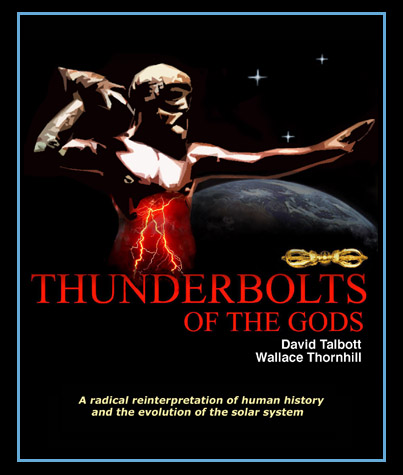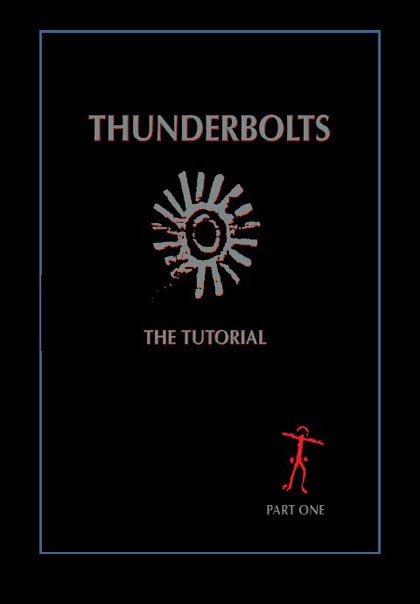
home •
about •
essential guide •
picture of the day •
thunderblogs •
news •
multimedia •
predictions •
products •
get involved •
contact
Credit: ESA
Plot of wind speed and direction from Descent Imager/Spectral Radiometer (DISR)
instrument on the Huygens probe (lower curves) and from Earth-based Doppler Wind
Experiment (upper curves).
pic of the day
archive
subject index
abstract
archive
Links:
Society for
Interdisciplinary
Studies

Thunderbolts of the Gods is a
108 page 8-1/2 x 11 full color monograph based on the life work of the two
authors--a revolutionary synthesis of comparative mythology and the
newly-discovered "Electric Universe".

The Monograph includes
an hour-long DVD introducing various aspects of the Electric
Universe explained by members of the Thunderbolts Group.
Dec 08, 2005
Titan's Winds
Titan’s “super-rotating” wind indicates a youthful body.
In the Electric Universe, Saturn’s moon Titan and the planet Venus likely have shared a common birth in an astronomically recent ejection event. Both have “young” surface features, such as filamentary channels and the absence of large craters, and their atmospheres share a number of common attributes. In standard theory, which postulates that all planets and moons formed from a nebular cloud of gas and dust billions of years ago, these commonalities can only be coincidental. But a theory of planet and moon formation that recognizes the electrical behavior of plasma discharges expects episodic accumulation, ejection, and sculpting of smaller satellite bodies from larger ones.
One common attribute of their atmospheres is “super-rotation” at a high altitude that slows to sluggish circulation near the surface. The wind at Venus’s cloud-tops circle the planet in 4 days; Venus rotates in the opposite direction once every 243 days. On Earth, winds are assumed to be generated by rotational displacements of convection currents between the equator and the poles. But Venus has an almost uniform heat distribution that is not likely to generate convection—and, besides, the surface is moving the wrong way.
As the diagram above shows, measurements taken by instruments aboard the Huygens descent probe dropped from the Cassini craft found a wind speed of 30 meters per second at 60 kilometers above the surface. At that rate, the wind would circle the moon in about 6 days. Titan rotates in just under 16 days. While Titan’s upper winds travel in the same direction as the moon, slow winds under 7 kilometers altitude travel in the opposite direction. (The left line in the diagram correlates with wind speed on the top scale; the right line correlates with wind direction on the bottom scale.)
Although mission scientists expected to find an ionospheric layer between 70 and 90 kilometers altitude, the Huygens probe discovered a second one at 60 kilometers. In addition, temperature measurements indicated that the atmosphere was composed of many layers. The probe appears also to have detected “possible lightning activity.”
An ionospheric layer is, of course, a plasma double layer. With Titan orbiting inside Saturn’s extensive plasmasphere, the electrical environment will dominate the atmospheric properties. That means the temperature, density and wind speed would all be affected. In particular, the high-level wind will be driven by the “Faraday motor” effect of the electric currents impinging on Titan. This is the same effect that we see on Titan's big sister, Venus.
The occurrence of lightning on both bodies is expected as “leakage currents” from the Faraday motor effect. Needless to say, standard theory is at a loss to explain it: The only mechanism postulated for lightning is friction among raindrops tossed about in convection flows. But neither Venus nor Titan has significant water and certainly not liquid water. Their atmospheres are better characterized as composed of smog. And as far as standard theory is concerned, you can’t get lightning in smog.
A super-rotating atmosphere of smog driven by electrical currents that leak “sparks” is indicative of a recently formed body that has not yet reached equilibrium. On this basis, the Electric Universe posits that both Venus and Titan are young.
EXECUTIVE EDITORS:
David Talbott, Wallace Thornhill
MANAGING EDITOR:
Mel Acheson
CONTRIBUTING EDITORS: Michael Armstrong, Dwardu Cardona, Ev Cochrane,
C.J. Ransom, Don Scott, Rens van der Sluijs, Ian Tresman
WEBMASTER: Michael Armstrong
Copyright 2005: thunderbolts.info